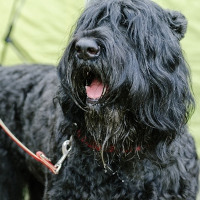Appearance of the Irish Russian Spanterrier
|
| The Irish Water Spaniel is a medium-sized dog, while the Black Russian Terrier is a giant breed, and their offspring will generally be large to very large. They are slightly longer than they are tall, giving them a rectangular shape, and will have strong, straight legs, although they may sport the thick, sickle-shaped tail of the Russian Black Terrier or the distinctive "rat tail" of the Irish Water Spaniel. Dogs that favor their Irish Water Spaniel heritage will have a chiseled head with a long, deep muzzle covered in fine, short hair, while those favoring the Black Russian Terrier will have a large, brick-shaped head with a broad but slightly tapering muzzle that has copious furnishings of hair that falls over the eyes and forms a mustache and beard. The eyes of this hybrid can range from dark brown to amber and can be oval or almond-shaped, and the ears can be set high or low on the skull, with those set high usually folding forward, while those set low most often hang over the side of the head, often exceeding the chin. The Irish Russian Spanterrier will have a double-layered coat consisting of a soft, dense undercoat covered by a water-repellent layer of outer hair that can be straight like the Russian Black Terrier, curly like the Irish Water Spaniel, or anything in between. |
Temperament of the Irish Russian Spanterrier
|
| The temperament of the Irish Russian Spanterrier can vary somewhat from individual to individual in terms of energy levels, tolerance and suitability for children, as well as territorial or protective behavior. Although Irish Water Spaniels and Russian Black Terriers are generally very tolerant of children, they can be a little too exuberant for younger dogs, especially in their teens. However, some negative traits can sometimes appear on both sides of the family tree, as the Irish Water Spaniel tends to be combative with other dogs and has a strong prey drive, and in rare cases, overprotective or territorial behaviors can appear with the Black Russian Terrier due to its guard dog nature. Early positive socialization can help mitigate many of these negative behavioral traits and encourage good behavior with strangers. This hybrid is at its best when it is able to spend as much time as possible with its family, and is prone to separation anxiety if left alone for too long. He's an extremely trainable dog who can usually master new commands quickly and consistently, but can become willful or distracted if bored. Try to vary your training routines regularly to avoid boredom and bring out the best in your dog. |
Needs and activities of the Irish Russian Spanterrier
|
| While the Black Russian Terrier may tend to be somewhat quiet, the Irish Water Spaniel is a very active dog, so the Irish Russian Spanterrier needs at least 60 to 90 minutes of vigorous exercise throughout the day every day to keep them happiest and healthiest. This crossbreed can develop skeletal disorders if it is allowed to play too rough or put too much strain on its joints by walking or jogging too far at a time during its teenage years. In addition to walking and jogging, this dog can also excel and enjoy activities such as obedience training, swimming, agility training and rallies. They'll appreciate a large yard to stretch out and explore, or regular visits to the dog park if space outside the home is limited. |
Maintenance of the Irish Russian Spanterrier
|
| Grooming requirements for this particular crossbreed are another area that can vary a little from dog to dog. Although it requires some effort, the coat of the Irish Water Spaniel parent is fairly simple to maintain, with bathing only required when necessary, particularly as thorough brushing and combing of the coat often removes much of the dust, dirt and grime that is stuck to the fur itself, and shedding is rare enough that this breed of dog is considered hypoallergenic. The coat of the parent Black Russian Terrier is a different story; they only require weekly brushing, but it takes some time to ensure that the coat is well detangled as their fur is very thick and dense, and their non-hypoallergenic coats require trimming or trimming at least twice a year. Your Irish Russian Spanterrier will have a dense, long coat, although the texture and tendency to tangle depend on the dominant genes. Your hybrid's ears should be checked often for excess moisture or dirt. A routine for teeth cleaning and nail trimming is also recommended. |









 English (United Kingdom)
English (United Kingdom)